Want to learn how to play easy worship songs on piano for your church community? Then this lesson is for you!
The first time I ever saw a chord chart was at church. The worship leader knew I played piano, but I had only ever played classical music. Still, I got assigned to the piano, and it was super daunting at first! But I soon learned how easy playing from chord charts is. And that it’s super fun.
This lesson is designed to give you the confidence to play piano at for your church community. We’ll teach you three easy worship songs and decode some of the chord chart symbols you may encounter.
Inspiring tutorials. Fascinating articles. Exclusive interviews. We create piano content anyone, anywhere can enjoy for free. Don’t miss out, sign up for more free lessons.
This lesson assumes that you know a little bit about chording, while taking things slow. If you’re new to chords, try these lessons first:
Prefer a more hands-on approach? Try our free Chord Hacks series.
I love this song because it’s a modern twist on a traditional classic. Our version is in C major, which means you won’t have any black keys to worry about. Yay!
But wait…what do all these slashes mean?
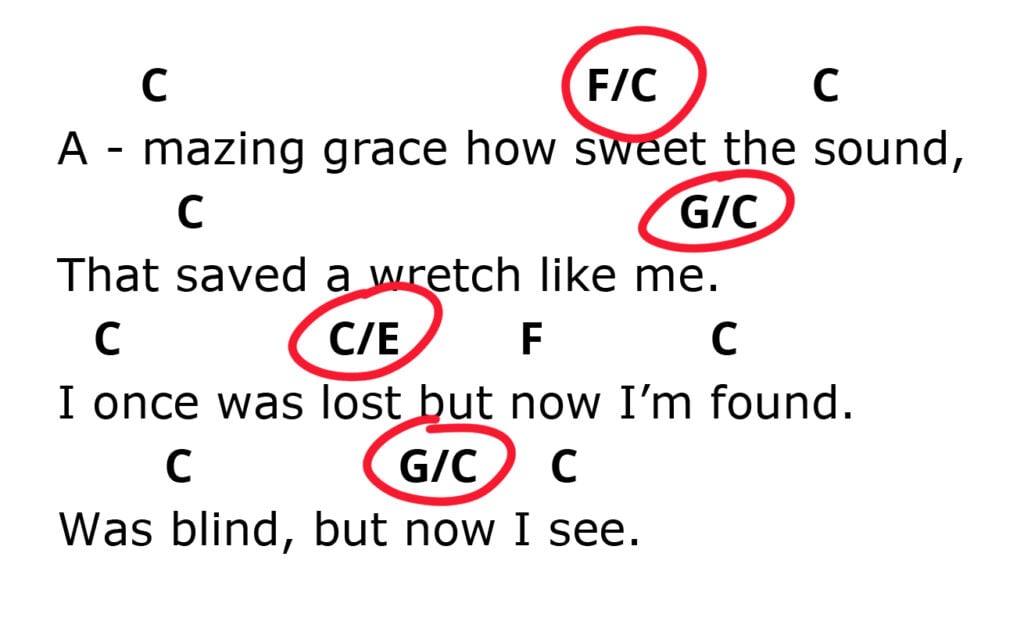
Those are called slash chords. Let’s take F/C as an example.
The letter on the left of the slash tells you what chord to play with your right hand. The letter on the right tells you what note to play with your left hand.
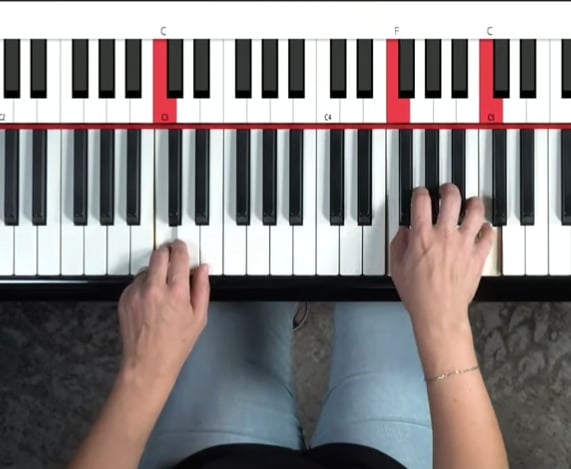
You can also think of it as playing an F major triad over the note C.
This is one of the most requested worship songs I get, which is awesome because it’s also a great song for beginners.
there’s another funny-looking chord here, one that is quite common in worship music: Dsus4.
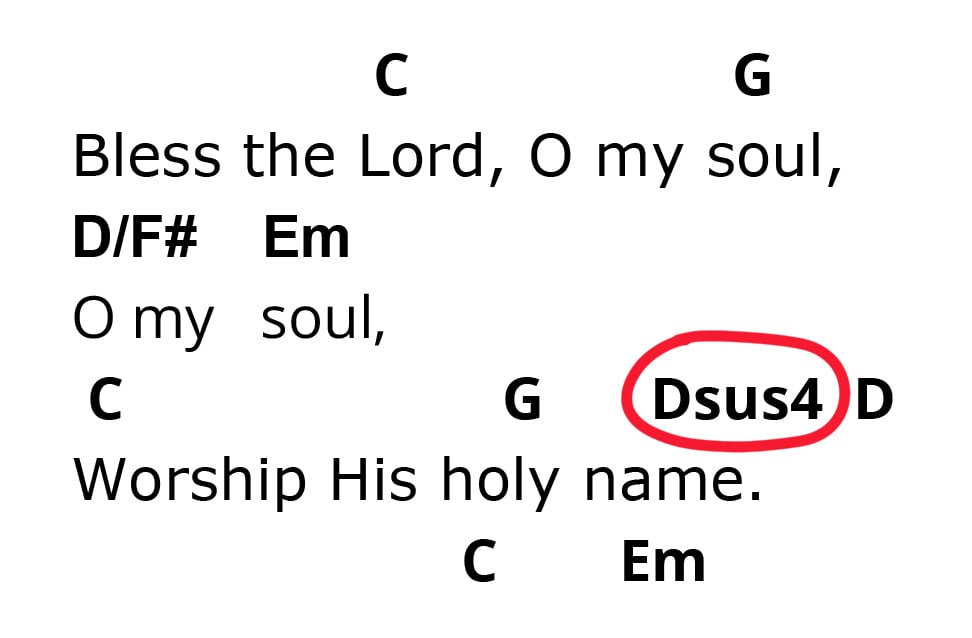
You can play a normal D major triad here, but sus chords are quite easy and can add a lot more character to your sound.
“Sus” is short for “suspended.” In a sus4 chord, we swap the third note for the fourth above the root. So, for Dsus4, we replace the third (F#) with a fourth (G).
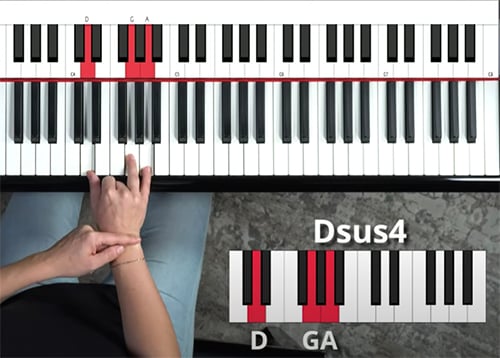
Sus chords create an unfinished sound, which why most sus chords resolve to the major chord immediately. You’ll see that Dsus4 moves quickly to a D.
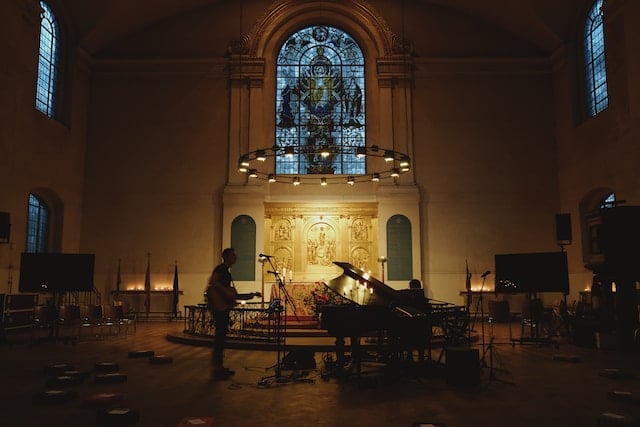
The piano is the glue that holds worship bands together. And being a church pianists, serving your community, and playing with others who share your passion is a truly rewarding experience. Learn to play piano at church with confidence with our worship course taught by Lisa Witt and Amberly Martz. Free with your Pianote membership.
Our final song in this lesson is a classic, but it may be a little tricky because of its time signature. It’s in 6/8, which means it has a little swing to it. I suggest listening to the song first to get a good sense of the rhythm.
You’ll notice that in this song, we have a minor 7th chord!

A minor triad works here too, but the Bm7 adds color.
A seventh chord is when we add the seventh note of the scale to the chord. In Bm7, that seventh note is A. Therefore, our Bm7 chord is B-D-F#-A.
But you don’t need to play all these notes in that exact order. In fact, prefer to put the 7th note below the root note and play A-B-D-F#. Like this:

It’s a lot more comfortable for me and my small hands!
Play around with the other chords in this song. There are only three, which makes it ideal to experiment with 🙂
As you can see, it only takes a little bit of chord knowledge (and bravery) to play piano in church!
Modern worship songs are not complicated, and the most common chord types you can expect to find are the ones we’ve covered in this lesson. So, playing at church is an excellent way to learn how to play the piano using chord charts and how to play with other people — all while giving back to your community!
If you’d like to explore worship piano more, we have an entire course designed to teach you how to play piano in church. It’s a 10-lesson, step-by-step course that will walk you through all the skills you’ll need, so you can feel confident joining a worship team.
Happy practicing!
Your musical journey starts today: try Pianote and get access to drum, vocal, and guitar lessons too!
Lisa Witt has been teaching piano for more than 20 years and in that time has helped hundreds of students learn to play the songs they love. Lisa received classical piano training through the Royal Conservatory of Music, but she has since embraced popular music and playing by ear in order to accompany herself and others. Learn more about Lisa.


By signing up you’ll also receive our ongoing free lessons and special offers. Don’t worry, we value your privacy and you can unsubscribe at any time.
We use cookies for traffic data and advertising. Cookie Policy »